Ping Liu
Automated anatomy-based post-processing reduces false positives and improved interpretability of deep learning intracranial aneurysm detection
Jul 01, 2025Abstract:Introduction: Deep learning (DL) models can help detect intracranial aneurysms on CTA, but high false positive (FP) rates remain a barrier to clinical translation, despite improvement in model architectures and strategies like detection threshold tuning. We employed an automated, anatomy-based, heuristic-learning hybrid artery-vein segmentation post-processing method to further reduce FPs. Methods: Two DL models, CPM-Net and a deformable 3D convolutional neural network-transformer hybrid (3D-CNN-TR), were trained with 1,186 open-source CTAs (1,373 annotated aneurysms), and evaluated with 143 held-out private CTAs (218 annotated aneurysms). Brain, artery, vein, and cavernous venous sinus (CVS) segmentation masks were applied to remove possible FPs in the DL outputs that overlapped with: (1) brain mask; (2) vein mask; (3) vein more than artery masks; (4) brain plus vein mask; (5) brain plus vein more than artery masks. Results: CPM-Net yielded 139 true-positives (TP); 79 false-negative (FN); 126 FP. 3D-CNN-TR yielded 179 TP; 39 FN; 182 FP. FPs were commonly extracranial (CPM-Net 27.3%; 3D-CNN-TR 42.3%), venous (CPM-Net 56.3%; 3D-CNN-TR 29.1%), arterial (CPM-Net 11.9%; 3D-CNN-TR 53.3%), and non-vascular (CPM-Net 25.4%; 3D-CNN-TR 9.3%) structures. Method 5 performed best, reducing CPM-Net FP by 70.6% (89/126) and 3D-CNN-TR FP by 51.6% (94/182), without reducing TP, lowering the FP/case rate from 0.88 to 0.26 for CPM-NET, and from 1.27 to 0.62 for the 3D-CNN-TR. Conclusion: Anatomy-based, interpretable post-processing can improve DL-based aneurysm detection model performance. More broadly, automated, domain-informed, hybrid heuristic-learning processing holds promise for improving the performance and clinical acceptance of aneurysm detection models.
Fed-HeLLo: Efficient Federated Foundation Model Fine-Tuning with Heterogeneous LoRA Allocation
Jun 13, 2025Abstract:Federated Learning has recently been utilized to collaboratively fine-tune foundation models across multiple clients. Notably, federated low-rank adaptation LoRA-based fine-tuning methods have recently gained attention, which allows clients to fine-tune FMs with a small portion of trainable parameters locally. However, most existing methods do not account for the heterogeneous resources of clients or lack an effective local training strategy to maximize global fine-tuning performance under limited resources. In this work, we propose Fed-HeLLo, a novel federated LoRA-based fine-tuning framework that enables clients to collaboratively fine-tune an FM with different local trainable LoRA layers. To ensure its effectiveness, we develop several heterogeneous LoRA allocation (HLA) strategies that adaptively allocate local trainable LoRA layers based on clients' resource capabilities and the layer importance. Specifically, based on the dynamic layer importance, we design a Fisher Information Matrix score-based HLA that leverages dynamic gradient norm information. To better stabilize the training process, we consider the intrinsic importance of LoRA layers and design a Geometrically-Defined HLA strategy. It shapes the collective distribution of trainable LoRA layers into specific geometric patterns, such as Triangle, Inverted Triangle, Bottleneck, and Uniform. Moreover, we extend GD-HLA into a randomized version, named Randomized Geometrically-Defined HLA, for enhanced model accuracy with randomness. By co-designing the proposed HLA strategies, we incorporate both the dynamic and intrinsic layer importance into the design of our HLA strategy. We evaluate our approach on five datasets under diverse federated LoRA fine-tuning settings, covering three levels of data distribution from IID to extreme Non-IID. Results show that Fed-HeLLo with HLA strategies is both effective and efficient.
Erasing Concepts, Steering Generations: A Comprehensive Survey of Concept Suppression
May 26, 2025Abstract:Text-to-Image (T2I) models have demonstrated impressive capabilities in generating high-quality and diverse visual content from natural language prompts. However, uncontrolled reproduction of sensitive, copyrighted, or harmful imagery poses serious ethical, legal, and safety challenges. To address these concerns, the concept erasure paradigm has emerged as a promising direction, enabling the selective removal of specific semantic concepts from generative models while preserving their overall utility. This survey provides a comprehensive overview and in-depth synthesis of concept erasure techniques in T2I diffusion models. We systematically categorize existing approaches along three key dimensions: intervention level, which identifies specific model components targeted for concept removal; optimization structure, referring to the algorithmic strategies employed to achieve suppression; and semantic scope, concerning the complexity and nature of the concepts addressed. This multi-dimensional taxonomy enables clear, structured comparisons across diverse methodologies, highlighting fundamental trade-offs between erasure specificity, generalization, and computational complexity. We further discuss current evaluation benchmarks, standardized metrics, and practical datasets, emphasizing gaps that limit comprehensive assessment, particularly regarding robustness and practical effectiveness. Finally, we outline major challenges and promising future directions, including disentanglement of concept representations, adaptive and incremental erasure strategies, adversarial robustness, and new generative architectures. This survey aims to guide researchers toward safer, more ethically aligned generative models, providing foundational knowledge and actionable recommendations to advance responsible development in generative AI.
MAGIC: Motion-Aware Generative Inference via Confidence-Guided LLM
May 22, 2025Abstract:Recent advances in static 3D generation have intensified the demand for physically consistent dynamic 3D content. However, existing video generation models, including diffusion-based methods, often prioritize visual realism while neglecting physical plausibility, resulting in implausible object dynamics. Prior approaches for physics-aware dynamic generation typically rely on large-scale annotated datasets or extensive model fine-tuning, which imposes significant computational and data collection burdens and limits scalability across scenarios. To address these challenges, we present MAGIC, a training-free framework for single-image physical property inference and dynamic generation, integrating pretrained image-to-video diffusion models with iterative LLM-based reasoning. Our framework generates motion-rich videos from a static image and closes the visual-to-physical gap through a confidence-driven LLM feedback loop that adaptively steers the diffusion model toward physics-relevant motion. To translate visual dynamics into controllable physical behavior, we further introduce a differentiable MPM simulator operating directly on 3D Gaussians reconstructed from the single image, enabling physically grounded, simulation-ready outputs without any supervision or model tuning. Experiments show that MAGIC outperforms existing physics-aware generative methods in inference accuracy and achieves greater temporal coherence than state-of-the-art video diffusion models.
Erased or Dormant? Rethinking Concept Erasure Through Reversibility
May 22, 2025Abstract:To what extent does concept erasure eliminate generative capacity in diffusion models? While prior evaluations have primarily focused on measuring concept suppression under specific textual prompts, we explore a complementary and fundamental question: do current concept erasure techniques genuinely remove the ability to generate targeted concepts, or do they merely achieve superficial, prompt-specific suppression? We systematically evaluate the robustness and reversibility of two representative concept erasure methods, Unified Concept Editing and Erased Stable Diffusion, by probing their ability to eliminate targeted generative behaviors in text-to-image models. These methods attempt to suppress undesired semantic concepts by modifying internal model parameters, either through targeted attention edits or model-level fine-tuning strategies. To rigorously assess whether these techniques truly erase generative capacity, we propose an instance-level evaluation strategy that employs lightweight fine-tuning to explicitly test the reactivation potential of erased concepts. Through quantitative metrics and qualitative analyses, we show that erased concepts often reemerge with substantial visual fidelity after minimal adaptation, indicating that current methods suppress latent generative representations without fully eliminating them. Our findings reveal critical limitations in existing concept erasure approaches and highlight the need for deeper, representation-level interventions and more rigorous evaluation standards to ensure genuine, irreversible removal of concepts from generative models.
Grounding Creativity in Physics: A Brief Survey of Physical Priors in AIGC
Feb 10, 2025
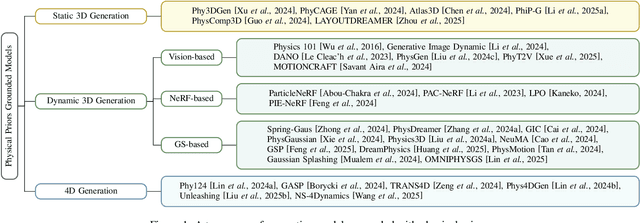

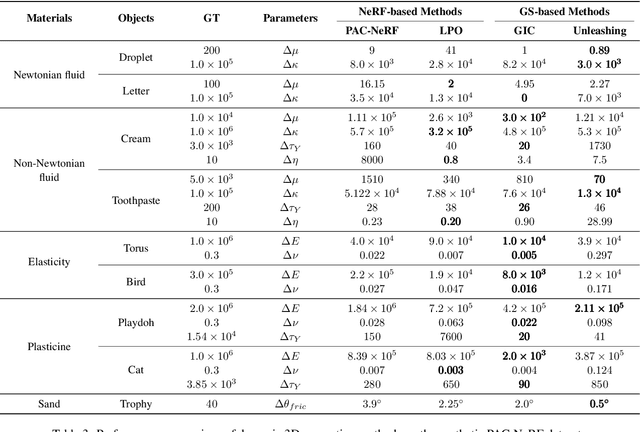
Abstract:Recent advancements in AI-generated content have significantly improved the realism of 3D and 4D generation. However, most existing methods prioritize appearance consistency while neglecting underlying physical principles, leading to artifacts such as unrealistic deformations, unstable dynamics, and implausible objects interactions. Incorporating physics priors into generative models has become a crucial research direction to enhance structural integrity and motion realism. This survey provides a review of physics-aware generative methods, systematically analyzing how physical constraints are integrated into 3D and 4D generation. First, we examine recent works in incorporating physical priors into static and dynamic 3D generation, categorizing methods based on representation types, including vision-based, NeRF-based, and Gaussian Splatting-based approaches. Second, we explore emerging techniques in 4D generation, focusing on methods that model temporal dynamics with physical simulations. Finally, we conduct a comparative analysis of major methods, highlighting their strengths, limitations, and suitability for different materials and motion dynamics. By presenting an in-depth analysis of physics-grounded AIGC, this survey aims to bridge the gap between generative models and physical realism, providing insights that inspire future research in physically consistent content generation.
The Evolution of Dataset Distillation: Toward Scalable and Generalizable Solutions
Feb 08, 2025



Abstract:Dataset distillation, which condenses large-scale datasets into compact synthetic representations, has emerged as a critical solution for training modern deep learning models efficiently. While prior surveys focus on developments before 2023, this work comprehensively reviews recent advances, emphasizing scalability to large-scale datasets such as ImageNet-1K and ImageNet-21K. We categorize progress into a few key methodologies: trajectory matching, gradient matching, distribution matching, scalable generative approaches, and decoupling optimization mechanisms. As a comprehensive examination of recent dataset distillation advances, this survey highlights breakthrough innovations: the SRe2L framework for efficient and effective condensation, soft label strategies that significantly enhance model accuracy, and lossless distillation techniques that maximize compression while maintaining performance. Beyond these methodological advancements, we address critical challenges, including robustness against adversarial and backdoor attacks, effective handling of non-IID data distributions. Additionally, we explore emerging applications in video and audio processing, multi-modal learning, medical imaging, and scientific computing, highlighting its domain versatility. By offering extensive performance comparisons and actionable research directions, this survey equips researchers and practitioners with practical insights to advance efficient and generalizable dataset distillation, paving the way for future innovations.
CLIP-SR: Collaborative Linguistic and Image Processing for Super-Resolution
Dec 16, 2024Abstract:Convolutional Neural Networks (CNNs) have advanced Image Super-Resolution (SR), but most CNN-based methods rely solely on pixel-based transformations, often leading to artifacts and blurring, particularly with severe downsampling (e.g., 8x or 16x). Recent text-guided SR methods attempt to leverage textual information for enhanced detail, but they frequently struggle with effective alignment, resulting in inconsistent semantic coherence. To address these limitations, we introduce a multi-modal semantic enhancement approach that combines textual semantics with visual features, effectively tackling semantic mismatches and detail loss in highly degraded LR images. Our proposed multi-modal collaborative framework enables the production of realistic and high-quality SR images at significant up-scaling factors. The framework integrates text and image inputs, employing a prompt predictor, Text-Image Fusion Block (TIFBlock), and Iterative Refinement Module alongside CLIP (Contrastive Language-Image Pretraining) features to guide a progressive enhancement process with fine-grained alignment. This alignment produces high-resolution outputs with crisp details and semantic coherence, even at large scaling factors. Through extensive comparative experiments and ablation studies, we validate the effectiveness of our approach. Additionally, by incorporating textual semantic guidance, our technique enables a degree of super-resolution editability while maintaining semantic coherence.
RIGI: Rectifying Image-to-3D Generation Inconsistency via Uncertainty-aware Learning
Nov 28, 2024Abstract:Given a single image of a target object, image-to-3D generation aims to reconstruct its texture and geometric shape. Recent methods often utilize intermediate media, such as multi-view images or videos, to bridge the gap between input image and the 3D target, thereby guiding the generation of both shape and texture. However, inconsistencies in the generated multi-view snapshots frequently introduce noise and artifacts along object boundaries, undermining the 3D reconstruction process. To address this challenge, we leverage 3D Gaussian Splatting (3DGS) for 3D reconstruction, and explicitly integrate uncertainty-aware learning into the reconstruction process. By capturing the stochasticity between two Gaussian models, we estimate an uncertainty map, which is subsequently used for uncertainty-aware regularization to rectify the impact of inconsistencies. Specifically, we optimize both Gaussian models simultaneously, calculating the uncertainty map by evaluating the discrepancies between rendered images from identical viewpoints. Based on the uncertainty map, we apply adaptive pixel-wise loss weighting to regularize the models, reducing reconstruction intensity in high-uncertainty regions. This approach dynamically detects and mitigates conflicts in multi-view labels, leading to smoother results and effectively reducing artifacts. Extensive experiments show the effectiveness of our method in improving 3D generation quality by reducing inconsistencies and artifacts.
MICAS: Multi-grained In-Context Adaptive Sampling for 3D Point Cloud Processing
Nov 25, 2024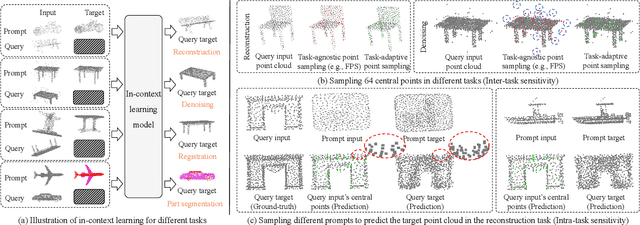
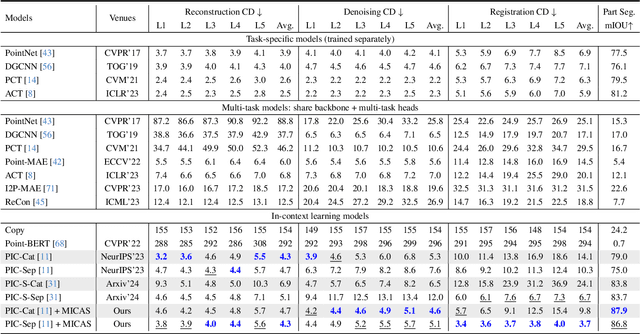
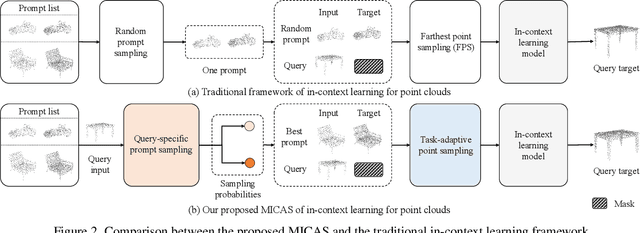
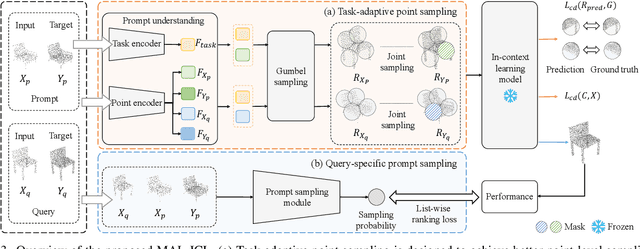
Abstract:Point cloud processing (PCP) encompasses tasks like reconstruction, denoising, registration, and segmentation, each often requiring specialized models to address unique task characteristics. While in-context learning (ICL) has shown promise across tasks by using a single model with task-specific demonstration prompts, its application to PCP reveals significant limitations. We identify inter-task and intra-task sensitivity issues in current ICL methods for PCP, which we attribute to inflexible sampling strategies lacking context adaptation at the point and prompt levels. To address these challenges, we propose MICAS, an advanced ICL framework featuring a multi-grained adaptive sampling mechanism tailored for PCP. MICAS introduces two core components: task-adaptive point sampling, which leverages inter-task cues for point-level sampling, and query-specific prompt sampling, which selects optimal prompts per query to mitigate intra-task sensitivity. To our knowledge, this is the first approach to introduce adaptive sampling tailored to the unique requirements of point clouds within an ICL framework. Extensive experiments show that MICAS not only efficiently handles various PCP tasks but also significantly outperforms existing methods. Notably, it achieves a remarkable $4.1\%$ improvement in the part segmentation task and delivers consistent gains across various PCP applications.
 Add to Chrome
Add to Chrome Add to Firefox
Add to Firefox Add to Edge
Add to Edge